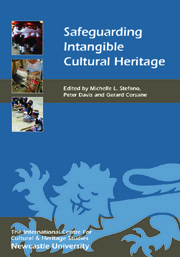Book contents
- Frontmatter
- Contents
- List of Illustrations
- Acknowledgments
- Touching the Intangible: An Introduction
- NEGOTIATING AND VALUING THE INTANGIBLE
- 1 The Paradoxes of Intangible Heritage
- 2 Memory, Museums and the Making of Meaning: A Caribbean Perspective
- 3 From Intangible Expression to Digital Cultural Heritage
- 4 Conversation Piece: Intangible Cultural Heritage in Sweden
- 5 Africa's Rich Intangible Heritage: Managing a Continent's Diverse Resources
- 6 The Silence of Meanings in Conventional Approaches to Cultural Heritage in Jordan: The Exclusion of Contexts and the Marginalisation of the Intangible
- 7 Conversation Piece: Intangible Cultural Heritage in India
- APPLYING THE INTANGIBLE CULTURAL HERITAGE CONCEPT
- ON THE GROUND: SAFEGUARDING THE INTANGIBLE
- List of Contributors
- Index
4 - Conversation Piece: Intangible Cultural Heritage in Sweden
from NEGOTIATING AND VALUING THE INTANGIBLE
Published online by Cambridge University Press: 05 February 2013
- Frontmatter
- Contents
- List of Illustrations
- Acknowledgments
- Touching the Intangible: An Introduction
- NEGOTIATING AND VALUING THE INTANGIBLE
- 1 The Paradoxes of Intangible Heritage
- 2 Memory, Museums and the Making of Meaning: A Caribbean Perspective
- 3 From Intangible Expression to Digital Cultural Heritage
- 4 Conversation Piece: Intangible Cultural Heritage in Sweden
- 5 Africa's Rich Intangible Heritage: Managing a Continent's Diverse Resources
- 6 The Silence of Meanings in Conventional Approaches to Cultural Heritage in Jordan: The Exclusion of Contexts and the Marginalisation of the Intangible
- 7 Conversation Piece: Intangible Cultural Heritage in India
- APPLYING THE INTANGIBLE CULTURAL HERITAGE CONCEPT
- ON THE GROUND: SAFEGUARDING THE INTANGIBLE
- List of Contributors
- Index
Summary
Can you say something about yourself and your personal interest in ICH?
I have been involved in museum work in Sweden for the last 30 years in different positions, carrying out a variety of tasks. Independent of where or in which museum, intangible heritage has always been very important to me, because I regard it as creating the context and supplying the detailed knowledge for the interpretation of material culture and the environment. In other words, through ICH the physical objects and places come alive and their meaning and their history can be understood and interpreted.
During my years as director of Ekomuseum Bergslagen in the late 1990s, this fact was most apparent. In this ‘landscape museum’, which involves many different sites spread out across a large geographic area, the main emphasis was on mining and industrial processes connected to metalworking. We dealt with a kind of cultural heritage where the skills and knowledge of iron making, the craft skills and traditions connected to mines and industrial plants in this specific region in Sweden, were paramount. The experience of working with local inhabitants, volunteers and members of local societies made me understand the great importance of recognising all people as active agents; it was these individuals who were responsible for handing over their knowledge of cultural heritage to the next generation. Such knowledge was encapsulated as habitual behaviours, rituals, norms, values, skills and experiences; however, because these forms of ICH were moulded and manipulated, the process was a dynamic one and ICH changed as people left their own stamp on their heritage.
- Type
- Chapter
- Information
- Safeguarding Intangible Cultural Heritage , pp. 47 - 56Publisher: Boydell & BrewerPrint publication year: 2012



